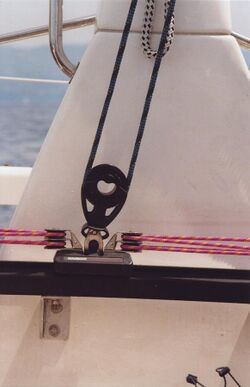Physics:Mechanical traveller
A mechanical traveller is a moving part of a machine, typically a ring that slides between different positions on a supporting rod when the machine goes through its operating cycle. The term may also be used refer to the supporting rod.

In sailing, it is a mechanical device used to modify the location at which lines used to control sails (such as sheets) are attached to the vessel. The attachment is often by means of a block through which the line runs; the block can move along the traveller. This allows independent control of the direction and tension of the line running through the block, which allows the sailor to position the block in the optimal location for the wind conditions and desired sail trim. This kind of traveller is often a metal track, which is attached to the deck of the boat. The block is attached to a "car", which much like a miniature railroad car, attaches to the track and slides along it in either direction. A traveller on a smaller craft (such as the popular single-handed "Laser" sailboat) might simply be a line attached to two points on the deck, along which another block runs. The term traveller can also be applied to the specialized lines used to control the location of the block.
The block used to support a load on a jackstay is referred to as a traveller or traveller block.[1] It works in much the same way as a sheet traveller, in that it supports the load to be transported along the jackstay and is slid along the jackstay by control lines attached to both sides.
References

